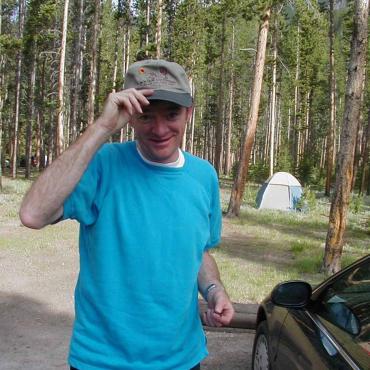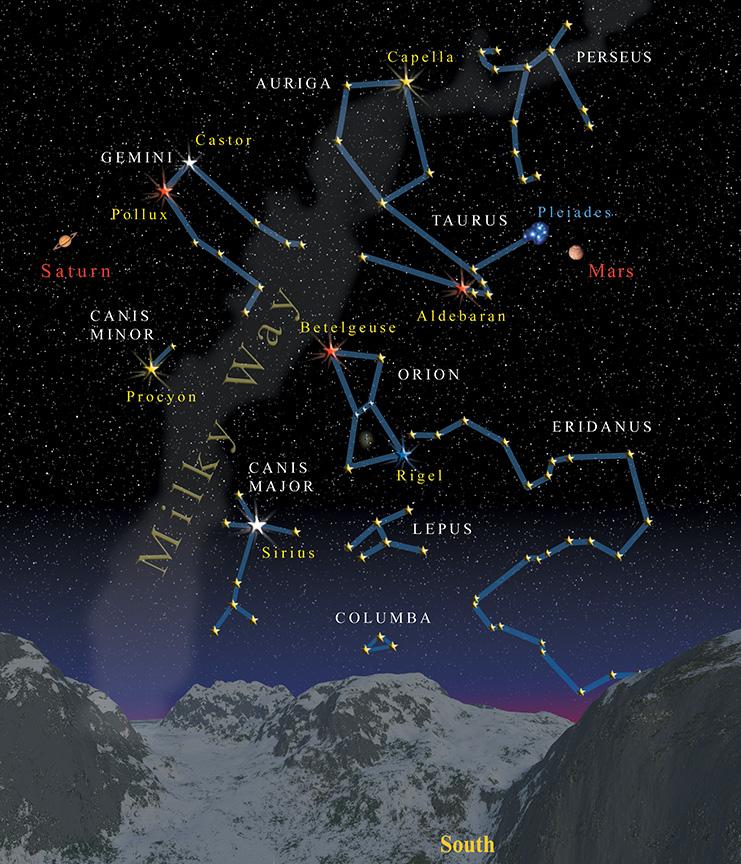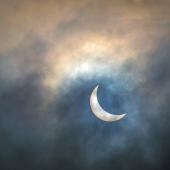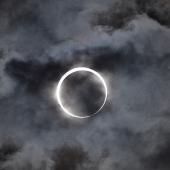The Hounds of Heaven
Winter astronomy.
I’m convinced that there must be an obscure Montana statute stating that anybody who owns a home—or a pickup—must also own at least one dog. For canines abound in the Montana landscape the way stars litter the heavens on a clear, dark night.
The four-legged woofer’s exhalted status as “Man’s Best Friend” is an ancient one, and if it’s recognized in the lonely stretches of the Northern Rockies, it’s also recognized in the sky. For the winter heavens host two starry pooches following their master, Orion the hunter, in a tableau that could have been lifted right from the fields and forests of our modern-day hunting season.
To find the heavenly hounds, it’s good to first find Orion, striding high across the south on cold winter nights. He rises at sunset around Christmas, and lies due south around 11:00 pm in mid-January and by 9:00 pm in mid-February. His belt of three stars is easy to locate; just trace a line from the belt downward to the left and you’ll run into bright white Sirius, the brightest star in Canis Major, the Great Dog, and in fact the brightest star in the sky by virtue of the fact that it actually is bigger and brighter than the sun and is also one of the closest stars to us at a mere 8.6 light years away.
Sirius itself is known as the Dog Star. To the Cherokee, it was one of the two “barking dogs” of the sky (the other being summertime’s Antares), the guardians of the Path of Souls—better known today as the Milky Way. When you died, it was said, you had to take food along with you to travel this path. By offering some to the first dog, you could slip past and get onto the path while he ate. But you had to save some dog chow for the second at the other end if you wanted to get off and into the Land of Souls.
To the Greeks, Sirius was only part of the Great Dog—sometimes marking the snout, sometimes the neck where it makes a dandy jewel in the dog’s collar. A stick figure body, legs and tail can be readily traced among the stars below it. Look up and left of Sirius, and you’ll spy yellowish Procyon, the bright star of Canis Minor, the Lesser Dog. Better to call it the Hot Dog, perhaps, for Procyon and a fainter star alongside are its only significant stars. Procyon is another of the nearest stars at about 11 light years away, and both Sirius and Procyon subscribe to this Man’s Best Friend business as well, each having a small white dwarf companion star of its own.
Aside from a few Disneyesque movies and tales, our puppies tend to fill supporting roles in our stories, and so it is with these heavenly canines. As the sporting dogs of Orion, they accompanied him on his forays into the fields and forests of ancient Greece. On one such outing, Orion happened upon a lovely band of sisters in a clearing. Startled, the sisters fled, triggering the hunting instinct in burly Orion and his hounds. They gave chase until the gods heard the frightened entreaties of the sisters and turned the maidens into doves, who flew up into the sky to become the Pleiades star cluster. Eventually Orion was placed in the sky as well, along with his dogs—right behind the sisters as if to continue the chase. So the gods prudently stuck a large, well-horned bull named Taurus between Orion and the Pleiades to keep Orion busy—and his mind off of the girls. They also placed a swift hare named Lepus at Orion’s feet, perhaps to keep his dogs occupied as well. And so the whole ensemble chases each other westward each winter’s night—perhaps to keep us occupied as we watch this lovely star-spangled stretch of sky wheel overhead on the coldest of nights. (And this stretch is additionally spangled this winter by the bracketing planets Mars and Saturn who add their orangey and yellowish tones to a sky filled with bright stars.)
Just remember: if it’s cold enough to be a “three-dog night”—an Inuit notion that it’s sufficiently frigid to require snuggling with three sled dogs to keep warm—don’t forget that you can find two of them in the sky.
Jim Manning, formerly the executive director of the Astronomical Society of the Pacific in San Francisco, lived outside Bozeman for many years and has returned to live here once again.













